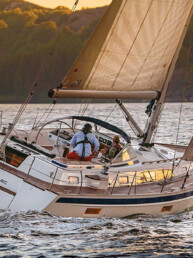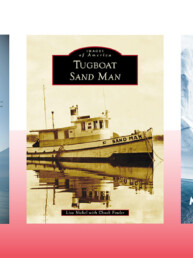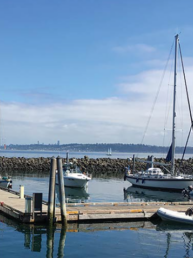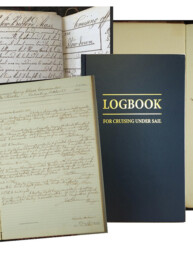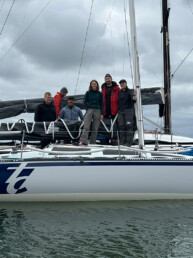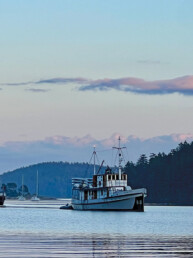This article originally appeared in the May 2021 issue of 48° North.
Date: August 25-26
Trip: Saltair (Stuart Channel) to Princess Cove (Wallace Island)
Weather: Sunny + Hot
Notes: First time to Wallace Island and it was spectacular! Stern tied in Princess Cove right next to the dinghy dock. Deb + Randy came to meet us for a few hours, then headed home. We made dinner, then went for an amazing dinghy ride – endless stars, the call of a loon, the sounds of harbor seals. Magical.
We recently went through our boat’s logbook, something we’ve rarely done in the past. Flipping through the years of experiences and memories contained on the pages of the three-ring binder was both surprising and gratifying.
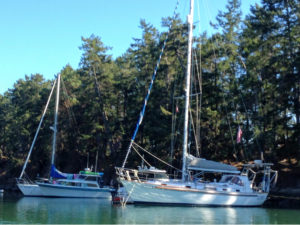 Most importantly, it got us thinking about the real benefit of creating and maintaining a logbook and why, going forward, we plan to be more committed to keeping that tradition alive, even as we rethink the traditional approach to keeping a log.
Most importantly, it got us thinking about the real benefit of creating and maintaining a logbook and why, going forward, we plan to be more committed to keeping that tradition alive, even as we rethink the traditional approach to keeping a log.
We’re in the midst of renaming our boat, which includes the important step of removing the old name, wherever it’s located on and in the vessel. Otherwise, we might tempt the wrath of a certain underwater deity on whose good side we wish to remain.
Unfortunately, our customized logbook that lives in our navigator’s station had the old name on every page. Rather than physically removing the book and consigning it to storage, we decided instead to scan the hand-written pages produced over the past nine years of cruising this boat in and around the Salish Sea and beyond. These pages are now in the cloud, well out of sight of anyone residing under the sea, but easy enough for us to pull up whenever needed.
According to Wikipedia, “a logbook (a ship’s logs or simply log) is a record of important events in the management, operation, and navigation of a ship. It is essential to traditional navigation, and must be filled in at least daily.”
It goes on to say, “Today’s ship’s log has grown to contain many other types of information, and is a record of operational data relating to a ship or submarine, such as weather conditions, times of routine events and significant incidents, crew complement or what ports were docked at and when.”
When we bought our Passport 40 back in 2012, we needed a new logbook and carefully constructed a page template that sought to capture what we felt was the most
important information.
In addition to the date, trip, distance traveled, weather conditions and forecast, we included fields for recording port and starboard fuel and water tank levels, and battery voltage and amp hours for both start and house banks. We could record engine hours and average speed. There was even a place to list the holding tank level.
Wikipedia would have been proud.
All of this data is important for any competent boater to know and track while underway. At least in theory. And I suppose our thinking was that filling these in each day would act as a sort of checklist to make sure we weren’t forgetting to fill the fuel tanks — or empty the holding tanks.
It’s useful to know how much fuel your engine consumes in various conditions, and whether your average speed underway is changing for better or worse. If we were cruising offshore, I’m sure we would have included a field for hourly estimated position to help with dead reckoning (as a backup to our GPS, of course).
For a while, anyway, we did a good job of filling in most of those fields. But within a few months of using our new logbook, some of the fields started looking a little bare. We still checked battery voltage and state of charge every day, but we stopped taking the time to record it. Same with fuel and water
tank levels.
Half the time, when we departed for the day’s travels, I would forget to record the time. And when we arrived, rather than write down the time, it was usually time for a beer.
But the one field we did fill out nearly religiously was the one at the bottom, simply titled “Notes.” Looking back, this contained the most important information in the entire logbook — the observations we’d want to access years and miles down
the road.
Sometimes the entries under notes were short, such as “Anchored and dropped two crab pots.” Other times, they meandered past the bottom of the page and on to the blank backside. They reflected our individual writing styles, with Marty’s being mostly clipped sentences about key events and reflections, and Deborah’s being more coherent narratives of the time we spent afloat and ashore.
Date: August 20
Trip: Nanaimo to Hornsby Island
Weather: 25-30 knots NW, sunny
Notes: Sea-trialed the autopilot and it worked great. Headed out to the straits and was immediately met by an awful sea state. Waves were 4-6 feet, steep and very close together. Wind was right on the nose. And the current was running 2 knots against. Boat handled very well, but I punched through the waves making only 3-4 knots headway. After about 3 hours, and with the forecast for increasing winds, decided to turn back. Within the hour, conditions moderated. Damn.
As we scanned our old logbook pages for digital posterity, it was the notes section that we lingered over time and time again. Some of the events recorded there are logged in our heads as clear as day. Others would have been lost to the fog of fading memories. And sometimes they dispelled long-running disputes about where we were when we heard that plaintive loon cry or who took that incredible black-and-white photo of the crumbling old ferry dock.
By the time we departed for our three-month long cruise to Southeast Alaska and back in 2018, the initial pages of the logbook were full. We meant to print more before we left, but somehow that little chore was lost in the avalanche of more pressing details that required our attention.
So we did something we hadn’t done before — we started keeping a log on our iPads. I realize this might send old salts sputtering, “It has to be done with pen and paper, otherwise you might lose it!”
But we didn’t lose it. We weren’t using the log for dead reckoning. And rather than skipping over a whole bunch of blank fields we weren’t going to fill out anyway, we just sat down and wrote up our “notes.”
Freed from the confines of the template, with no limits on length, we could just write about the most important things — our experiences underway and how they made us feel. For fun, we often took screenshots of the day’s route from the backup navigation program on our phones and inserted those in our new “log.”
For the past two years, we’ve just kept our notes on our iPads, safely backed up in the cloud. The boat’s logbook has become more of a place for us to share reflections, express our inner thoughts and put down the moments, large and small, that make up a cruiser’s life.
At the end of the day, we decided that for us it’s better to keep temporary specific logs if we want to track fuel usage, boat performance measures or plot our position as we go.
The logbook was important less for its traditional purpose of navigating us safely to a new destination. Instead, it transformed into a richer tool for helping us navigate through our past as boaters, highlighting how we have grown and developed over our years of cruising.
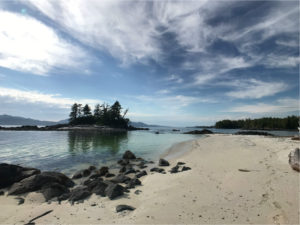 Date: June 20
Date: June 20
Destination: Fury Cove
Notes: I departed Goose Bay around 10:30, sounding a quick blast of the horn in salute. The fog that had rolled in the evening before gave signs of lifting. The short trip up to Fury Island cove was uneventful motoring …
The sun broke through and I admired the sandy beaches on the west end of the cove at low tide. Maybe it was the perfect 75 degree temperature, the light wind and the warm sun, but the beaches were to my mind the loveliest place I’ve been in the Pacific Northwest, or anywhere. The white sand, mixed with shells. The nearly turquoise water that lapped against the beach. The dark black rock buried in the sand and marking a million years of existence. The tree-covered islands and the view out to the ocean. It was sublime.

